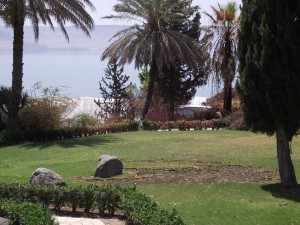I recently stood on the shores of the Sea of Galilee near where Jesus is thought to have spent much of his adult life in Capernaum. The village is right on the water, and the view of the sea is breathtakingly serene. When standing on the shore looking south, the rolling hills of the ancient Decapolis wrap around the east side of the Galilee, and the city of Tiberias highlights the low hills on the West that lead toward Nazareth. Directly below my feet were the pebbles that led toward the water’s edge.

In Jesus’s day, the Decapolis would have been a place that represented the gentile Hellenistic culture of the Roman Empire and Tiberias, a place largely espousing Jewish values and tradition. To the north of both, and where I stood on the shores of Galilee, I could picture Jesus making his way along the pebbles while looking out at the fishermen faithfully practicing their trade. In one breath this first-century rabbi invites the fishermen to follow him, and in the next they are walking right beside him into a story that would upend their lives.
Jesus’s invitation was to something as ancient as it was new. He was not inaugurating a new faith: he was fulfilling an ancient faith, but it wasn’t going to purely look like either the Hellenistic culture of the Decapolis or the Jewish culture of Tiberias. It was something that transcended culture and tradition and required full immersion into a way of life that reflected the rabbi. Jesus’s way countered the values of the Empire and the espoused traditions of the overly religious. In this sense, it didn’t require only physically turning toward the way of Jesus, but re-orienting and re-defining truth and faithfulness. For those of the Empire, Jesus’s way was confusing in the sense that he promoted selflessness and non-violence in contrast to a culture of self-promotion and violent dominance. For the religious, Jesus called into question some of the holiness codes they held most true as a means to remain faithful to the Torah and the coming Messiah.
Further, Jesus’s invitation was as complex as it was simple. In this light we can see why so many didn’t understand and act upon his invitation. At the same time, in his simple offers to “follow me” and “come and see,” the viral invitation of this all-of-life Jewish renewal movement was under way. It was not an invitation involving only a prayer, but an invitation that would call all of life into submission to the values of the renewed kingdom.
As a people who seek to listen and submerge into the relationships of our local contexts, we hope to invite others into our homes, life, and way of Jesus, but we also hope to be invited into the lives of others.We follow the model of Jesus, who, after living for thirty years alongside those in the Galilee region, began to invite others toward his new way of life, but was also invited into the homes and around the tables of others. In Luke 5 Jesus is the guest of honor at the home of a former tax collector. Jesus was so embedded in deep relationships that others were willingly extending invitations to him.
How might our lives and communities more faithfully reflect the all of life nature of Jesus’ invitation to this Third Way that rejected the lure of Empire and renewed/transformed the call of the religious? Have we bought into a faith “invitation” that is anything less? Are we inviting and being invited in the homes of our neighbors, co-workers and schoolmates?
Much of this content is from my book Thin Places published by The House Studio